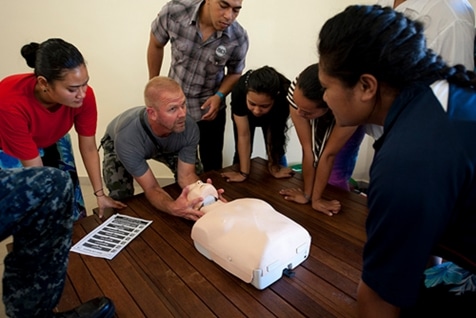So, you’ve gotten the most suitable Alsco First Aid Kit for your place of work, have it fully stocked, and agreed on a managed first aid kit schedule to keep it that way.
You’ve even ensured that an automated external defibrillator is part of the deal. That’s it, right? Well, not exactly.
While having a first aid kit and an AED on hand are important, both to meet health and safety regulations and increase the life-saving potential at your office, garage or retail outlet, they only go so far. Your staff also need to know how to perform CPR (cardiopulmonary resuscitation).
CPR is still vital, even with the new technology that is around today, principally because it can take a minute or two to get an automated external defibrillator ready to use. But studies have shown that every second counts, so keeping the heart pumping and oxygenated blood heading to the brain is essential.
Facts You Need to Know
CPR is not the cure to a cardiac arrest. In other words, it’s not going to restart the heart. The whole idea is to keep blood moving around the body so that the supply of oxygenated blood to the brain is not cut off.
Basically, CPR is designed to keep an individual alive until an automated external defibrillator can be found and utilised, or an ambulance arrives and proper emergency medical care can be provided.
There are actually 2 kinds of CPR:
- Conventional
- Compression-only CPR
The only difference between the two is that the conventional kind involves breathing into the person’s mouth – popularly known as ‘the kiss of life’.
A five-year study to 2010, by the University of Arizona, revealed that 5.2% of people suffering a out-of-hospital cardiac arrest survived without receiving CPR from a bystander, 7.8% survived with a bystander performing conventional CPR, and 13.3% when compression-only CPR was performed.
Make Sure Your Staff Is Trained
Modern OH&S legislation points out that every workplace should have at least one first aider who is trained to use a first aid kit effectively and perform first aid treatment, including CPR – so it’s a matter of law that staff members are trained.
The problem is that without training, the chances of a member of staff actually carrying out CPR on a colleague suffering cardiac arrest is drastically less.
A study by the Emergency Medicine Journal (Australia) in 2003 revealed that only 52% participants in the state of Victoria were trained in CPR, and that there were specific situations that affected the participants’ willingness to provide CPR to someone in need, and which kind.
For example, where there was a fear of not having sufficient skills, 19.8% stated they would be unwilling to perform compression-only CPR, while 19.4% said they would not perform conventional ‘mouth-to-mouth’ CPR.
Receiving proper training boosts confidence in staff members to save a life. It can also ensure that the technique applied when compressing is the correct one.
So, What to Do?
The steps are straightforward, with just 7 required to save a life.
- D – Check for Danger
- R – Check for a Response
- S – Send for Help
- A – Open the Airway
- B – Check Breathing
- C – Give 30 Chest Compressions
- D – Attach Automated External Defibrillator
But in the Alsco Greenroom, we would stress again the importance of gaining proper training from an accredited instructor.
You can contact your local health authority for detailed information on courses in your area, or contact your local St John Ambulance.
And to increase awareness around your workplace, you can hang up the attached poster, which was issued by the St John Ambulance. Click on the link to download for free.
Useful Links:
Alsco Resuscitation Chart: https://www.alsco.com.au/wp-content/uploads/2012/06/Alsco-DRASBCD.pdf
First Aid
Time is very previous when saving lives. With Alsco First Aid we can provide the best practice solutions for your business to get you first aid ready and compliant.
Visit www.alscofirstaid.com.au to discover the services we can provide or call us on 1300 077 391.
Further Reading and Information:
- ‘Statewide Study in Arizona Published in JAMA Show Chest-Compression-Only CPR Improves Survival’, The University of Arizona – http://opa.ahsc.arizona.edu/newsroom/news/2010/statewide-study-arizona-published-jama-show-chest-compression-only-cpr-improves-s
- ‘Is the Public Equipped to Act in Out of Hospital Cardiac Emergencies?’, Smith, Cameron, McR Meyer, McNeil, Emergency Medicine Journal (2003) – http://emj.bmj.com/content/20/1/85.full.pdf
- ‘How to Perform CPR’, American College of Emergency Physicians – http://emergencycareforyou.org/EmergencyManual/HowToPerformCPR/Default.aspx
Image courtesy: Commander, U.S. 7th Fleet


LEAVE A REPLY
Your email address will not be published. Required fields are marked *
You must be logged in to post a comment.